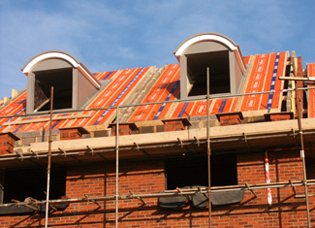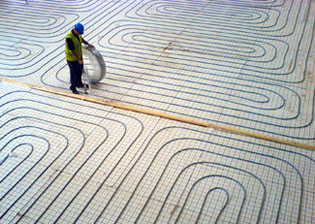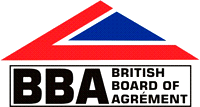EPS may mean Expanded Polystyrene but it also stands for the three things which are crucial to modern construction – Economy, Performance and Sustainability.
Only EPS offers a unique combination of attributes and advantages which has led to it being the leading choice for decades for architects and construction specifiers.
EPS is ideally suited for the following applications:

EPS floor insulation
EPS offers an exceptionally lightweight solution to so many applications in construction. This is not surprising when you consider that, as a result of advanced manufacturing technologies, EPS is effectively 98% air captured within a 2% cellular matrix.
The advantages in on-site handling and transportation bring significant economic benefits whilst considerably reducing health and safety risks associated with the lifting of heavier materials. It is therefore an excellent substitute for infill materials and ballast where it also brings load and fill times down in time-critical build projects.
In spite of its light weight, the unique matrix structure of EPS brings the benefits of exceptional compressive strength and block-rigidity. This means it is ideal for use in many construction and civil engineering applications, particularly as a structural base infill, for example in road, railway and bridge infrastructures.
Strength tests performed on EPS which was first placed in the ground almost 30 years ago show that it is just as strong today – the tested strength routinely exceeding the original minimum design strength of 100kPa.
EPS bridge foundations, which have been subject to many years of sustained loading, show ‘creep’ deformation of less that 1.3% – only half as much as had been theoretically predicted. Most importantly, EPS stability does not deteriorate with age.

EPS roofing
EPS is a well-established material for the construction industry and offers a proven and economic solution which helps specifiers maintain build costs and insulation budgets. Far from incurring a cost premium, the new-build cost of insulating a building with EPS, rather than polyurethane, polyisocyanurate or mineral wool, is typically 20% less. Floor construction with EPS requires only one waterproof membrane to be installed, not the two needed for mineral wool or PU foam – saving on both material and labour. For a given insulation performance, EPS itself costs less than these competing materials.
In the construction sector, EPS has a long established reputation for its exceptionally high insulation qualities. Its BRE ‘A-plus’ rating means it is the perfect choice for use in under-floor, between-floor, walling and roofing applications where it is able to give a constant insulation value across the full service life of the building.

EPS under-floor heating
Thermal conductivity testing of EPS to DIN 52612, under the auspices of the Forschungsinstitut für Wärmeschutz in Munich, confirmed that its insulation efficiency at 0.0345W/mK was well within the originally specified standard requirement of 0.04W/mK.
For those seeking higher performance material for the Code For Sustainable Homes (CSH), low lambda material is available – which is typically grey in colour. The thickness of high-performance, low lambda EPS can be as little as 70mm, making possible a total floor thickness of 135mm.
Ease of cutting or moulding allows the factory production or on-site preparation of complex shapes to match the most demanding architectural and design requirements – usually without the need for specialist cutting tools or skills. This means the breathing masks, goggles and protective gloves needed for working with mineral wool and other materials are not required with EPS.

EPS has a long and proven track record and has been tested to some of the world’s most demanding performance standards. EPS has BBA Approval, BRE Certification and many wider industry accreditations. Its light weight, high compressive and impact strength, insulation, safety and eco-credentials combine to make it the preferred option for so many architectural and construction applications.
After almost 30 years in the ground, samples of EPS retrieved from locations as little as 200mm above the groundwater level all have less than 1% water content by volume, whilst blocks which are periodically entirely submerged show less than 4% water content – performance notably superior to other foamed plastic materials.
EPS is non-toxic, chemically inert, non-irritant and rot-proof. Fungi and bacteria cannot grow on EPS and it is insoluble and non-hygroscopic.
EPS is also rodent-proof and offers no nutrient attraction to vermin. Nor is it affected by water, thus ensuring that moisture contact will not lead to deterioration of the product or its performance. In fact, the reinstatement of flood-damaged buildings is a much quicker, more practical and less costly procedure if building structures feature non-water-absorbing insulation material – waterlogged open-cell foams and mineral fibres are very vulnerable to flood damage, are very hard to dry out and may never recover their insulation performance.
Cement, lime, gypsum, anhydrite and mortar modified by plastics dispersions have no effect on EPS, so it can confidently be used in conjunction with all conventional types of mortar, plaster and concrete encountered in building construction. All of this makes it entirely safe in use across all of its construction applications including subterranean and marine environments.
At every stage of its life cycle, from production to recovery or recycling, EPS offers exceptional eco-credentials and is therefore ideally suited to the new generation of eco-friendly building projects. All manufacturing processes comply with current environmental regulation. EPS uses no greenhouse gas producing materials. It is chemically and environmentally non-aggressive and it can be – and is – easily recycled into long-life products through an expanding nationwide network of collection points.